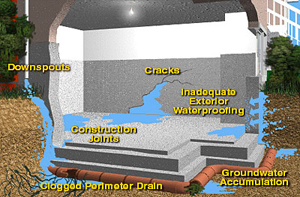Basement Waterproofing
Anyone who has mopped up a wet basement knows the damage that water leaves in its wake.
In addition to obvious problems such as peeling paint, the ruin of household goods, damp musty smells and the loss of valuable storage space, water can cause damage in slower and less obvious ways.
Damp timbers (wood joists and beams) can warp and bow, and are susceptible to the fungi that cause mold, mildew, dry rot and other possible health risks. Also, water in a basement makes any improvement or remodelling impossible.
 The battle against moisture is the most common basement problem faced by homeowners. It can range from seepage through the pores of walls and floors to water gushing through cracks, construction joints (e.g. where the floor and walls meet) or structural defects.
The battle against moisture is the most common basement problem faced by homeowners. It can range from seepage through the pores of walls and floors to water gushing through cracks, construction joints (e.g. where the floor and walls meet) or structural defects.
In spite of this, most basements have been built with little or no attention to preventing moisture problems.
When water seepage does occur, it is preferable to solve the problem from the inside so that the costly process of excavating the exterior of the foundation is avoided. However, for an inside application to be successful, it is important that the correct product be used.
Because conventional surface coatings rely on their adhesion to basement walls and floors, they frequently blister and peel off when subjected to water pressure and seepage. Many can only be applied to a completely dry surface and cannot therefore be used when needed most.
Xypex® provides homeowners with an industrially proven technology that has been used by contractors on the most demanding concrete waterproofing projects around the world for more than 25 years.
When mixed with water and applied as a cementitious coating, the active chemicals in Xypex® cause a catalytic reaction which generates a non-soluble crystalline formation of dendritic fibers within the pores and capillary tracts of concrete. This process permanently seals the concrete against the penetration of water or liquids from any direction.
 |
Step 1 - The Battle Snow and ice, wet dirt, groundwater -- foundations are exposed to many sources of water and moisture. Problems are often made worse by poor drainage, faulty gutters, and sprinklers. |
 |
Step 2 - The Water Leaks In Floor-wall cold joints, cracks, tie holes, capillaries, bleed paths, degrading tar coats, torn or delaminating membranes - water finds many ways to get through concrete. |
 |
Step 3 - Applying The Cure Applied from the inside or the outside, to new or old conrete, Xypex reacts with concrete byproducts to cause integral waterproofing. |
 |
Step 4 - Crystallization Begins Xypex causes a quartz-like dendritic crystalline structure to form within the capillary system of the concrete. It becomes a part of the concrete, not just a sealer that's stuck on the surface. |
 |
Step 5 - Water Leaks Are Stopped Xypex crystals fill all water paths through concrete. The crystals continue to develop in the concrete over time, blocking new water paths that develop, even years after application. The concrete "heals" itself. |
 |
Step 6 - Dynamic - Integral - Permanent Over time, the Xypex-catalyzed crystal growth forms a waterproof matrix throughout the entire interior of the foundation. Given enough time, the crystals will penetrate the entire mass of concrete. New cracks, should any form, will be sealed in an ongoing, dynamic process. |